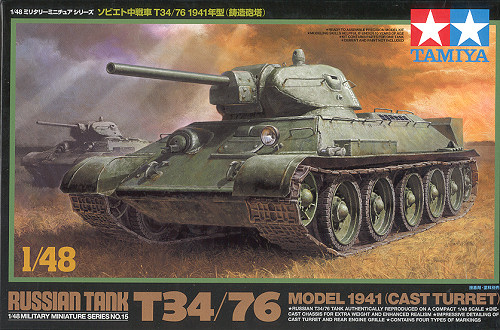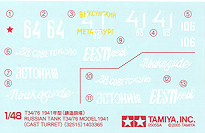
| KIT: | Tamiya 1/48 T-34/76 model 1941 |
| KIT #: | 32515 |
| PRICE: | $20.00 from Wings n Treads |
| DECALS: | four options |
| REVIEWER: | Scott Van Aken |
| NOTES: | cast metal lower hull |

| HISTORY |
"German Field Marshal Von Kleist said, "Their T-34 was the best in the world." The T-34 tank is legendary as the armored fighting vehicle that won The Great Patriotic War for the Soviet Union.
In 1931, the Soviet Union purchased two American Christie tanks, which were at the time the most innovative in the world and too advanced for the U.S. Army to get involved with. The main technological advance of the Christie design was the suspension system, which allowed the vehicle to operate at higher speeds over more difficult terrain than the various AFV suspension systems then in use. This Christie suspension system was incorporated in what became the T-34, and was the most important item in creating the superior fighting vehicle the T-34 was.
The T-34 was developed in the Kharkiv Tractor Factory in the Ukraine during 1936-37, as a technologically innovative design that addressed the short-comings of the earlier BT series of wheel/track tanks. These were light tanks designed for very high speed - 53 mph with tracks, and over 60mph in good roads without tracks! - and long range. While these features made a formidable weapon for fast advances deep in enemy territory, the BTs lacked firepower and armor and were not suitable as main battle tanks.
The prototype - now designated the T-34, was built in early 1939, was tested by successfully driving it 1,000 miles from Kharkiv to Moscow and back. It was put into production in September 1940. The Model 1940 carried the L-11 76.2mm gun, which was shorter than the subsequent 76.2mm main gun of the 1941 and later models. 1,225 T-34s had been produced at the Kharkov Steam-Engine Factory by the time of the German invasion on June 22,
Besides the suspension, the T-34's main advantage was its simple design, which made it easy to mass produce and repair. By the middle of the war, with mass production in the Urals factories, a T-34 could be produced in just 40 man hours. Compared to contemporary medium tanks, the T-34 was smaller and comparably lighter at only 26 tons, while the water-cooled diesel engine minimized the danger of fire and increased the radius of action to 115 miles.
The design evolved throughout the war: the T-34/76B was equipped with a rolled-plate turret, while the T-34/76C had twin roof hatches instead of the one large hatch, and the T-34/76D introduced a hexagonal turret, with a wider gun mantlet and jettisonable exterior fuel tanks. The T-34/76E had a cupola on the turret for the commander and all-welded construction, and the T-34/76F was equipped with a cast-steel rather than welded-steel turret.
The T-34 first saw action in a series of border battles between Russian and Japanese forces on the Manchurian border in March 1941. The Japanese reported the outstanding performance of the T-34, but these reports were ignored by the Wehrmacht.
When the German panzers first met the T-34 in combat, it proved to be a nasty surprise, since it had a more powerful high velocity cannon that placed more emphasis on tank killing ability than did the German Pzkw IV which was the heaviest German AFV at the time, and a higher top speed - 32 mph versus 25 mph. Additionally, its sloped armor and welded construction was superior to its opponent, while its extra-wide tracks improved cross-country mobility in the great battles on the Russian steppes. The T-34 was so superior to what the Germans had that an emergency program was put in place to create a tank that could counter it, which resulted in the Pzkw V, known as the Panther and the Pzkw VI, the Tiger. During the design competition that resulted in the Panther, one other suggestion was the production of a direct German copy of the T-34.
The T-34, equipped with hand bars welded to the hull, was the first tank designed to carry infantry into battle, which was a tactic that brought real changes to the battlefield, since the infantry could ambush enemy tanks that didnít expect their presence.
Following the Second World War, the T-34 was widely exported and saw action in nearly every war fought between 1945 and 1995, when it was used during the Bosnian civil war. T-34s can still be found in some armies in Africa, making it likely the most widely-used and longest-serving tank in history."
Few do a background history like Tom Cleaver and so I boldly swiped the above from his review!
| THE KIT |
 Molded in olive brown plastic, there are four sprues (two of them identical which contain the running gear bits and only one is shown). A cast metal hull is also included and really, I'm not quite sure why this is the case, aside from giving the kit a bit more heft.
Molded in olive brown plastic, there are four sprues (two of them identical which contain the running gear bits and only one is shown). A cast metal hull is also included and really, I'm not quite sure why this is the case, aside from giving the kit a bit more heft.
Detailing is excellent as one would expect from Tamiya. All but a few parts are used in construction. Will other versions of the T-34 be produced? Is the Pope German? This is the earliest production version so others are sure to follow. As with the StuG and Sherman I built, the chassis components are first glued onto the hull, then the upper body is built and screwed into place. Most of us will alter this so that we can paint the suspension and wheel bits. There are screws and two sizes of poly caps so many moveable bits are to be envisioned.
The tracks are in bits and sections. The bits to go around the drive sprockets and idler, while the larger sections will connect them. The upper tracks are formed to fit and have a bit of sag to them. One nice thing is that the number of ro ad wheels is much less than on similar tanks so less scraping and painting. A nice load of 'stuff' is provided to put on the outer body, including some spare tracks. The casting of the turret is first rate, though I can see that back seam will probably result in the loss of the casting marks. No interior in this one as these Tamiya kits are generally curbsides.
ad wheels is much less than on similar tanks so less scraping and painting. A nice load of 'stuff' is provided to put on the outer body, including some spare tracks. The casting of the turret is first rate, though I can see that back seam will probably result in the loss of the casting marks. No interior in this one as these Tamiya kits are generally curbsides.
The instructions are quite good, but again, only provide Tamiya color references. Not really a problem as you can have your T-34/76 in any shade you want as long as it is Russian Armor Green (of any one of several dozen shades). The small decal sheet provides markings for four different tanks. My experiences with Tamiya decals are quite positive so you can use these with abandon.
| CONCLUSIONS |
This one has to be another easy build, as attested by several others who have told me that not only are these tanks a breeze to do but make one look good when they are done. That's just fine for me and will add another interesting 1/48 armor model to my collection.
April 2006
Thanks to Wings n Treads for providing the review sample. Get yours at considerable discount from the hyperlink.
If you would like your product reviewed fairly and quickly by asite that has over 300,000 visitors a month, please contactme or see other details in the